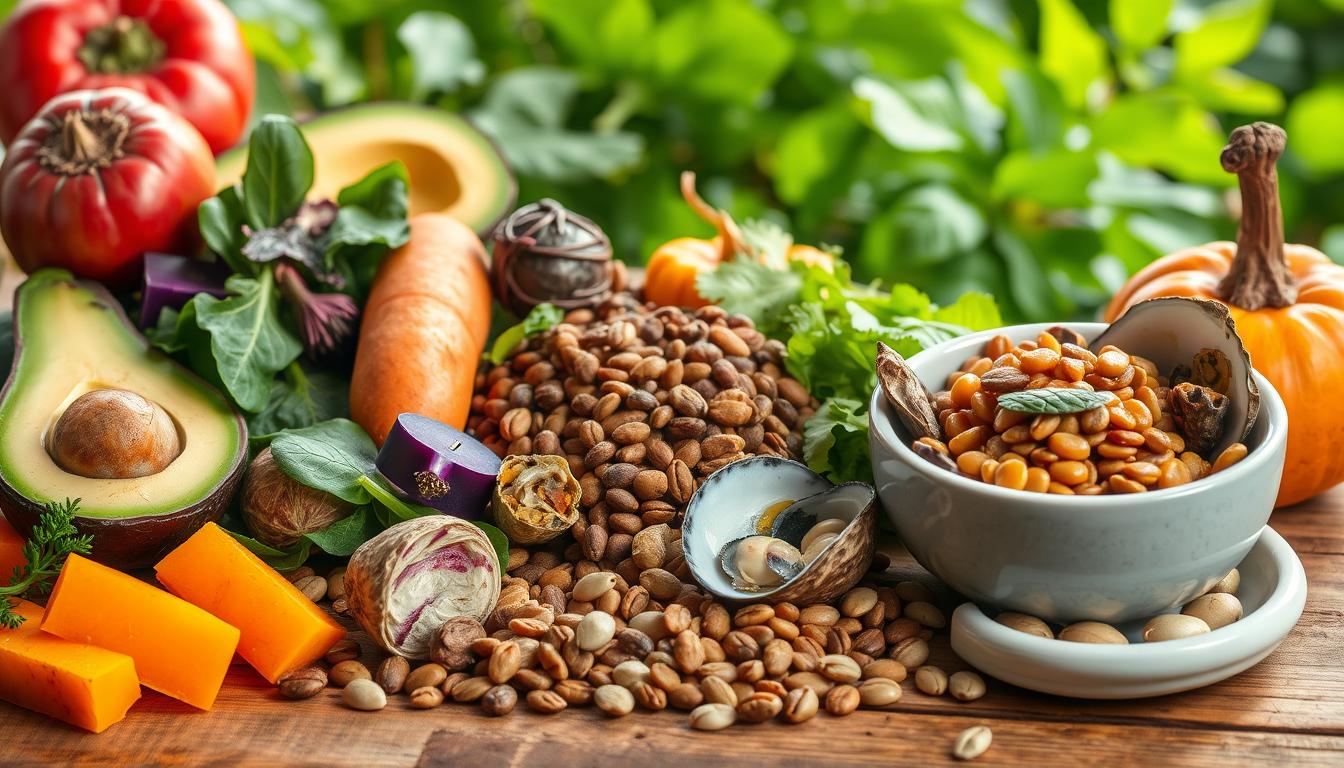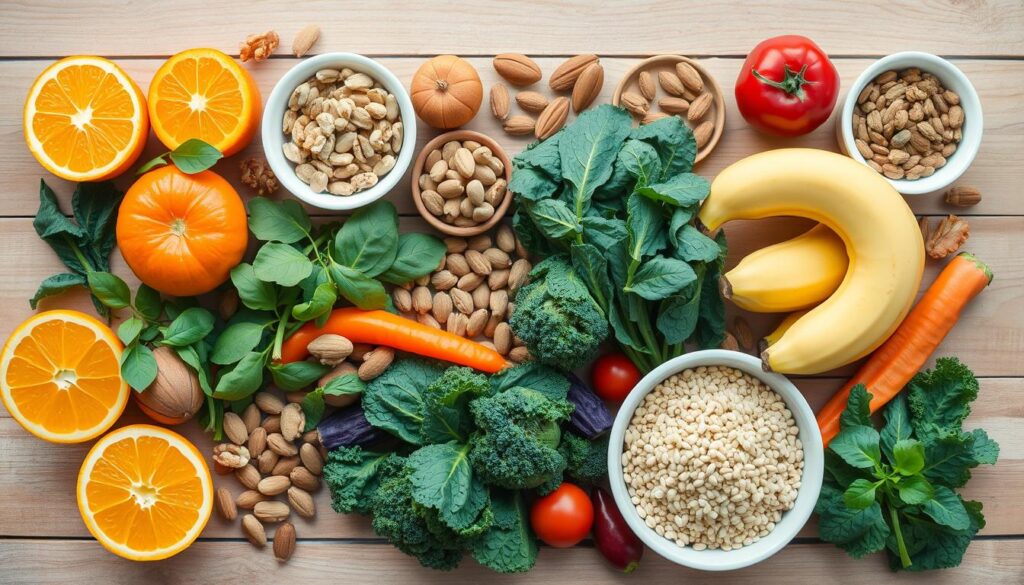Now Reading: Best Zinc and Copper Foods for Vitiligo Patients
-
01
Best Zinc and Copper Foods for Vitiligo Patients
- Home
- Vitiligo
- Diet & Nutrition
- Best Zinc and Copper Foods for Vitiligo Patients
Best Zinc and Copper Foods for Vitiligo Patients
fbshafiqk47@gmail.comDiet & Nutrition7 months ago57 Views

Unlock the healing potential of your diet with our guide on the best zinc and copper foods for vitiligo. Nourish your skin and find hope in every meal.
Vitiligo causes white patches on the skin, affecting how people feel about themselves. There’s no cure yet, but a balanced diet can help. Zinc and copper are key for healthy skin and a strong immune system.
For those with vitiligo, eating foods rich in zinc and copper is crucial. This article will explore the best foods for these nutrients. It aims to help you make better food choices to manage vitiligo.
Key Takeaways
- Vitiligo affects approximately 0.1-2% of the population.
- Zinc and copper are essential trace elements important for skin health.
- Dietary choices, including foods rich in zinc and copper, can support vitiligo management.
- Some patients have found certain foods beneficial, like bananas and leafy greens.
- It’s essential to avoid problematic foods such as alcohol and citrus fruits.
Understanding Vitiligo
Vitiligo is a tough autoimmune disease that makes the skin lose color. It happens when melanocytes, the cells that make melanin, get damaged or destroyed. People with vitiligo see depigmented patches on their skin. These patches can be different sizes and show up anywhere on the body.
The exact vitiligo causes are still a mystery. It’s thought that genetics, environment, and autoimmunity play a role. It’s important to know that vitiligo is not contagious. It can affect anyone, regardless of age, race, or gender.
Since it’s an autoimmune skin disease, managing it requires a few steps. This includes making lifestyle changes and sometimes medical treatment. Talking about nutrition and diets is key to helping people with vitiligo feel better.
Causes and Symptoms of Vitiligo
Vitiligo shows up as white patches on the skin. These patches can appear anywhere but often on the face, hands, and feet. Over time, these patches can grow, making them stand out against the rest of the skin.
Many things can start vitiligo. Autoimmune disorders are a big reason, as the immune system attacks the cells that make skin color. Genetics also play a part, with about 30% of cases linked to family history. Stress and skin injuries can make things worse, adding to the mix.
Knowing what causes vitiligo helps people get it treated sooner. It also helps them deal with the emotional and social effects. Finding out what triggers your symptoms can help you make changes to feel better.
The Importance of Nutrients in Vitiligo Management
Good nutrition is key in managing vitiligo. People with vitiligo often lack important nutrients, which can make their condition worse. The best vitamins and minerals for vitiligo include vitamin B12, vitamin D, folic acid, copper, and zinc. These nutrients help keep the immune system strong and support healthy skin.
It’s important to keep these nutrients at the right levels, especially since many people with vitiligo have deficiencies. For example, many have low vitamin D levels because they avoid the sun to protect their skin. Vitamin B12 deficiencies are also common, which can lead to conditions like pernicious anemia. This shows that treating nutrient deficiencies is a big part of managing vitiligo.
Studies have shown that oral supplements can help alongside other treatments like creams and light therapy. People who took supplements did better in clinical trials than those who didn’t. This knowledge helps doctors create better treatment plans for people with vitiligo.
| Nutrient | Role in Vitiligo Management | Common Sources |
|---|---|---|
| Vitamin B12 | Supports DNA synthesis and red blood cell formation | Meat, fish, dairy, fortified cereals |
| Vitamin D | Enhances calcium absorption and immune function | Fatty fish, fortified foods, sunlight |
| Folic Acid | Essential for DNA repair and synthesis | Leafy greens, legumes, fortified grains |
| Copper | Promotes the formation of melanin and connective tissues | Nuts, seeds, shellfish, whole grains |
| Zinc | Support immune function and wound healing | Meat, shellfish, beans, seeds, nuts |
Best Zinc and Copper Foods for Vitiligo Patients
Eating foods rich in zinc and copper is key for managing vitiligo. These foods help keep the skin healthy and boost overall health.
List of Copper-Rich Foods
- Mushrooms
- Nuts (almonds, cashews)
- Seeds (sesame, sunflower)
- Oysters
- Shellfish
- Whole grains
- Potatoes
- Organ meats
List of Zinc-Rich Foods
- Meats (beef, lamb, pork)
- Dairy products (milk, cheese, yogurt)
- Legumes (chickpeas, lentils, beans)
- Whole grains
- Nuts and seeds
Foods for Vitiligo
Eating well is key to managing vitiligo. Foods rich in antioxidants can help a lot. They fight oxidative stress and keep the skin healthy.
Antioxidant-Rich Foods Beneficial for Vitiligo
Antioxidant foods are great for your health and skin. Eating a mix of fruits and veggies with lots of antioxidants is smart. Here are some top picks:
- Berries – Full of vitamins and antioxidants, they boost the immune system.
- Spinach – It’s packed with nutrients that make your skin look better.
- Nuts – They offer healthy fats and antioxidants for your skin.
- Mango – A tasty fruit with vitamins A and C.
- Walnuts – Rich in Omega-3 fatty acids for skin care.
- Carrots – They’re full of beta-carotene, which is good for your skin.
- Dates – These sweet fruits help with skin pigmentation.
Let’s look at how these foods compare:
| Food | Antioxidant Properties | Benefits for Vitiligo |
|---|---|---|
| Berries | High in flavonoids | Supports immune function |
| Spinach | Rich in vitamins C and E | Promotes skin repair |
| Nuts | Contains vitamin E | Improves skin barrier |
| Mango | High in carotenoids | Enhances skin color |
| Walnuts | Source of omega-3 | Reduces inflammation |
Eating a variety of these foods can make a big difference. Regularly eating them can improve your skin and health over time.
How Zinc and Copper Influence Skin Health
Zinc and copper are key for skin health. They help with many skin functions. Zinc is great for zinc and copper benefits, like healing wounds and making collagen. It makes the skin strong against the environment.
Copper works with zinc to keep the skin elastic and firm. This is important for skin health, especially for people with conditions like vitiligo. People with vitiligo often have less zinc in their blood than healthy people.
Not getting enough zinc is a big problem worldwide. It affects about 33% of people. This can cause skin problems. It shows how important zinc and copper are for our skin.
| Element | Role in Skin Health | Common Sources |
|---|---|---|
| Zinc | Wound healing, immune response, collagen synthesis | Red meat, poultry, beans, nuts, whole grains |
| Copper | Supports elastin and collagen formation | Shellfish, seeds, nuts, whole grains, beans |

Identifying Copper Deficiency Symptoms
Copper deficiency can show up in many ways, hinting at health problems. Common signs of copper deficiency include feeling tired, weak, and anemic. People might also have weaker immunity and bones, leading to fractures. Skin health issues, like vitiligo, are also linked to copper deficiency.
Vitiligo patients face special challenges due to health issues related to copper deficiency. Studies show that vitiligo patients have lower copper levels than those without it. The mean serum copper level in vitiligo patients was 113.57 ± 59.43 μg/dL, while controls had 138.90 ± 38.14 μg/dL. This imbalance can affect skin color, making vitiligo harder to manage.
Spotting signs of copper deficiency early is key. If you’re always tired or weak, check your diet. Eating foods high in copper can improve your health, especially if you have vitiligo.
| Signs of Copper Deficiency | Related Health Issues |
|---|---|
| Fatigue | Weak immune system |
| Weakness | Anemia |
| Bone health deterioration | Skin issues |
| Low energy | Potential fractures |
Incorporating Zinc and Copper in Your Diet
Adding zinc and copper to your diet is easy and important for managing vitiligo. Eating a variety of foods helps you get the nutrients your skin needs. This is key for your overall health.
Start by adding nuts, seeds, and legumes to your meals. These are great sources of zinc and copper. Try:
- Pumpkin seeds
- Sunflower seeds
- Chickpeas
- Lentils
- Cashews
Lean meats like chicken and fish also help. Whole grains like quinoa and brown rice are good for you. Don’t forget green leafy veggies like spinach and kale.
Here’s a table showing foods high in zinc and copper:
| Food Item | Type | Zinc Content (mg per 100g) | Copper Content (mg per 100g) |
|---|---|---|---|
| Pumpkin seeds | Seed | 7.8 | 1.2 |
| Cashews | Nut | 5.0 | 2.2 |
| Spinach | Vegetable | 0.5 | 0.1 |
| Salmon | Fish | 0.6 | 0.1 |
| Dark chocolate | Snack | 3.3 | 1.8 |
By eating these foods regularly, you support your body’s needs. Making healthy food choices can really help manage your condition.

Foods to Avoid with Vitiligo
Managing vitiligo means making healthy choices and knowing which foods to avoid with vitiligo. Not everyone reacts the same to certain foods. But, some foods can make inflammation worse and make symptoms worse. For many, avoiding inflammation-triggering foods helps improve skin health.
Processed foods, refined sugars, and high-fat foods can cause more inflammation. So, it’s good to eat less of them. Here are some foods to avoid with vitiligo:
- Processed meats
- Citrus fruits
- Certain spices
- Seafood high in iodine
- Non-vegetarian food
- Artificial food colorings and preservatives
- Sour foods
- Genetically modified foods
- Red meat
- Alcoholic and caffeinated beverages
Choosing healthy choices for vitiligo patients can improve their health. Eating a diet full of fruits, vegetables, whole grains, and lean proteins is good for the skin. It’s important to watch how your body reacts to certain foods. Getting advice from healthcare providers or nutritionists can help make a plan that works for you.
| Food Type | Reason to Avoid |
|---|---|
| Processed Foods | May increase inflammation |
| Refined Sugars | Can trigger skin issues like acne and eczema |
| Citrus Fruits | Potentially worsen skin sensitivity |
| High-Iodine Seafood | Could trigger autoimmune reactions |
| Artificial Colorings | May provoke inflammatory responses |
Supplementing Zinc and Copper for Vitiligo
Supplementing zinc and copper can help manage vitiligo, especially for those who find it hard to get enough from food. These minerals are key for skin health and help nourish the skin from the inside. Not having enough zinc or copper can really hurt the skin and overall health.
Before starting supplements, it’s important to talk to a healthcare professional. They can help find the right amount to take, avoiding any bad interactions with other medicines. Taking the right amount is crucial for the best results and to get the most out of these important minerals.
- Quality dietary supplements with zinc and copper
- Regular tests for nutrient levels
- Eating a balanced diet with these minerals
Getting advice from a healthcare professional is key. They can suggest the best supplements based on your health. Using the right nutrients helps nourish the skin and fight vitiligo’s challenges.
| Supplements | Zinc (mg) | Copper (mg) | Benefits |
|---|---|---|---|
| Zinc Supplements | 15-25 | – | Supports immune function and skin health |
| Copper Supplements | – | 2-3 | Helps make melanin and connective tissues |
| Combined Zinc and Copper | 15 | 1 | Best balance for skin health |
Deciding to take zinc and copper supplements should be a thoughtful choice. It’s a step towards better skin health and a better life for those with vitiligo.
Conclusion
Vitiligo is a complex condition without a single cure. Yet, a diet rich in nutrients is a key part of managing it. Foods packed with vitamins A, C, D, and E, along with minerals like zinc and copper, are crucial for skin health. They help repair skin, reduce inflammation, and boost overall health.
Recommended foods for vitiligo include colorful fruits and veggies, lean proteins, whole grains, and healthy fats. Salmon, walnuts, and chia seeds are great choices. They not only add to your diet but also help fight inflammation. Avoiding processed foods and allergens is also important for your health journey.
By choosing nutrient-rich foods, you can improve your skin health and life quality. Managing vitiligo through diet means making smart food choices. It’s about eating a variety of healthy foods and possibly seeing your skin improve over time.
FAQ
What is vitiligo, and what causes it?
Vitiligo is a skin disease where pigment cells are lost. This leads to white patches on the skin. The exact cause is still unknown but may include genetics, immune system issues, and environmental factors.
How can nutrition impact vitiligo?
Eating a diet full of nutrients can help your skin and immune system. Foods rich in zinc and copper might help manage vitiligo symptoms.
What are the best foods high in zinc and copper for vitiligo patients?
For copper, eat shellfish, seeds, nuts, and whole grains. For zinc, choose meats, dairy, legumes, and whole grains. These foods can improve your skin health.
What are some signs and symptoms of copper deficiency?
Copper deficiency can cause fatigue, weakness, and anemia. It can also affect your skin and pigmentation, which is a big concern for those with vitiligo.
Can I supplement zinc and copper for better management of vitiligo?
Yes, supplements can help if you don’t get enough from food. But, always talk to a doctor before starting any supplements.
Are there any foods I should avoid if I have vitiligo?
Some people might want to avoid processed foods, refined sugars, and high-fat diets. These can cause inflammation and affect your skin.
What other vitamins and minerals are beneficial for vitiligo?
Besides zinc and copper, B12, D, and folic acid are key. They help your immune system and skin health, which is important for managing vitiligo.
How does a balanced diet support skin health in vitiligo patients?
A diet full of antioxidants, vitamins, and minerals fights oxidative stress. It can help improve your skin health and reduce some symptoms of vitiligo.
Related Posts
Previous Post
Next Post
Previous Post
Next Post
Recent Posts
- How to Use Aloe Vera for Vitiligo
- How to Make Detox Water for Vitiligo Patients: A Complete Guide
- Oats Recipes for Vitiligo Patients: Nourish Your Skin
- Treat Lip Vitiligo at Home: Natural Remedies
- Green Juice Recipe for Vitiligo Patients – Natural Remedy
- How to Use Babchi Oil for Vitiligo Treatment: A Complete Guide
- Michael Jackson’s Vitiligo: Understanding the Skin Condition
- Cure Vitiligo in 30 Days at Home – Natural Remedies
- Cure Vitiligo in 30 Days at Home – Natural Remedies
- Effective Sunscreen Use for Vitiligo Skin: Complete Protection Guide


















